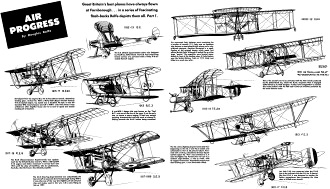|
By the time these aeroplanes
arrived on the world's airfields, barely a decade had passed since Wilbur and Oliver
Wright made their famous flight in 1903 at
Kitty Hawk. World War I
broke out in the middle of 1914, and planners quickly realized the value of air
power as soon as daring pilots proved the unmatched ability (by ground forces) ability
to conduct surveillance and attacks well behind enemy lines. Avoiding ground fire
was a relatively simple matter of flying high enough to keep out or range of bullets
and rockets. However, it was not long before opposing forces found themselves battling
each other high above the ground battle. Air-to-air combat had begun, proving the
ruggedness of both man and machine. A time period of 1908 through 1919 is presented
in this installment of "Air Progress" appearing in a 1960 issue of American
Modeler magazine. Biplanes stilled ruled the day, with monoplanes being too
fragile to hold up under the demands of high-G aerobatic maneuvering.
Air Progress
 Great Britain's best planes have always
flown at Farnborough ... in a series of fascinating flashbacks Rolfe depicts them
all. Part 1. Great Britain's best planes have always
flown at Farnborough ... in a series of fascinating flashbacks Rolfe depicts them
all. Part 1.
1912-13 B.E.
The B.E. (British Experimental) series was designed by Geoffrey deHavilland.
First B.E. had warp-wing lateral control, was powered with a 70-hp v-8 air-cooled
Renault engine.
1915-17 B.E2c
Developed from the original B.E. the 2c had aileron control, cleaned-up landing
gear, vertical fin. With a 90-hp RAF (Royal Aircraft Factory) V-8 air-cooled engine,
top speed was a doubtful 70 mph. It was the standard RFC reconnaissance aircraft
in WW-I until 1916 when it was withdrawn after frightful losses due to its lack
of sped and totally inadequate armament.
1913 B.E.3
A pre-WW-I design this was known as the "bad B.E." and one of the few of the
type, if not the only one, to mount a rotary engine. It had very serious spinning
characteristics and did much to arouse ill feeling toward the R.A.E. before being
scratched.
1917-19 R.E.8
The R.E.8 (Reconnaissance Experimental) was replacement for the ill-fated B.E.2c
and 2e's. With a 120-hp RAF V-12 engine and better armament it served from late
1916 until the close of hostilities. Like its predecessors, the B.E.s, the R.E.8
had a four-bladed propeller.
1917-1919 S.E.5
The S.E.5 (Scouting Experimental) was undoubtedly the best aircraft to emanate
from Farnborough during WW-I. It was also one of the very best fighters of all nationalities
and makes used in this war. S.E.'s were flying as late as 1937.
Farnborough, now famous as the scene of the annual SBAC (Society of British Aircraft
Constructors) displays in which the British show off their aviation wares, was,
many years ago, the very cradle of British military aviation and it was here, on
Laffan's Plain, that S. F. Cody, an employee of the Royal Aircraft (Factory) Establishment,
made the first official airplane flight of 496 yards in 1908. Prior to this historic
event the "establishment" had been chiefly engaged in producing man-lifting kites
(Cody), free balloons and dirigibles, the most famous of which was the "Nulli Secundus"
flown in 1907. Besides Cody the outfit retained the services of Dunne, noted designer
of automatically stable, tailless aircraft. Around 1910 Dunne and Cody were replaced
by the brilliant young designer, Geoffrey deHavilland, who was responsible for the
B.E. serles of tractor biplanes and who later became founder of the still existing
deHavilland Aircraft Company. The role of the government factory at Farnborough
has often been criticized in aviation circles and it was probably due to the mounting
opposition that the purely manufacturing end was abandoned after WW-I though research
goes on to this day.
1908-12 Cody
The mammoth Cody biplanes were interesting for a number of reasons. S. F. Cody
was an American who became a naturalized British citizen and a rule-of-thumb designer.
Machine illustrated is a modification of the original design which made first official
British flight. Although it looked like a rather large "pusher" the propellers were
located immediately in front of the leading edge. A Cody biplane won the British
Military Trials in 1912. Cody was killed in a crash soon after.
1910 DeHavilland No.2 Re-Designated as the F.E.I
This is the aircraft (not to be confused with the later D.H.2) produced by the
deHavilland Co.) which the R.A.E. acquired when it engaged deHavilland as its chief
designer. It takes some imagination to connect this crude boxkite with the 600 mph
Comet jet airliners produced by the same famous name.
1915-19 F.E.2B
The F.E. series (Fighting Experimental) had their beginnings in the F.E.2 and
F.E.3 models and culminated in the F.E.2b pictured above. Powered with a 160 h.p.
Beardmore 6-in-line liquid-cooled engine the "Fee" was intended as a 2-seat day-fighter
but finished the war out as a medium night-bomber, a role to which, with its rugged
construction, dependable engine and oleo landing gear, it was admirably suited.
1913 F.E.3
1915-17 F.E.8
The little F.E.S was patterned after the D.H.2 (not to be confused with the D.H.
No.2 shown). Like the D.H.2 it was designed to combat the Fokker monoplanes then
sweeping the skies clear of Allied recon aircraft.
Posted April 30, 2022
|


